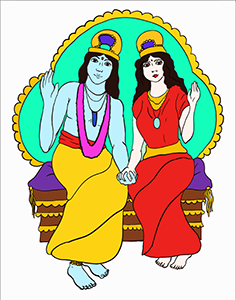Watch nearly 400 videos on the Vocal Medicine Channel!
Sita Ram Mantra & Stories
There are many Sita Ram mantras. Some are simple repetitions of the names of Sita and Ram. Other mantras relate some aspect of the story of the goddess Sita, her counterpart Ram, and his loyal friend and servant Hanuman, the monkey-faced Hindu god.
Sita is a Hindu goddess known for good character and happiness. She is an incarnation of Lakshmi, the goddess of wealth. Sita is the central female character of the Hindu epic Ramayana.
Share this page with a friend!
Adventures of Sita and Ram
She represents courage, dedication and purity. Sita goes through many trials together with her consort Ram, an incarnation of Vishnu, including exile and kidnapping. Eventually she is rescued with the help of Ram’s loyal friend Hanuman, the money-faced god. Learn more in the article on Hanuman.
Symbolism of Ram and Sita
Ram and Sita are sometimes viewed as symbolizing the unmanifest and the manifest minds or the pineal and pituitary glands. Sita and Ram are the ideal spouses. While Sita represents courage, dedication and purity, Ram (or Rama) represents truth, the soul and virtue.
Masculine and Feminine Balance
On the physical level, reciting the names of Sita and Ram is believed to balance both sides of the brain. They represent the yin and the yang or the masculine and the feminine. Sita and Ram are viewed as ideal, devoted spouses. The name Ram is also the seed syllable for the solar plexus chakra.
Power of the Sita Ram Mantra
The impact of vowels and consonants on the body and the mind is an amazing science. There appears to be a coded formula in many sacred languages that directly stimulates various systems and organs in the body. There are also mudras (hand positions) and body movements that correspond to each note of the scale.
Consonants and Vowels in Mantras
At a fundamental level, vowels are feminine energy: consonants are masculine energy. Vowels are generic and formless. Consonants set parameters around the feminine energy to create form from formlessness. In other words, consonants create a container.
Sonic Power of Vowels
Every sound literally vibrates the cells, bones, organs, and fluids in the body. The sonic power of vowels is recognized in many languages and systems. In the eastern tradition, Sanskrit vowels correspond with various bodily systems.

Formula of the Sita Ram Mantra
In the Sita Ram mantra, there is a pattern of consonants and vowels with specific energetic effects:
- The word “Sita” starts with the consonant “S.” An “S” is a consonant related to the energy of gathering from all directions.
- This is followed by the “EE” sound (long “I”) which has a positive effect on the brain and is thought to alleviate depression.
- The consonant “T” is an explosion of energy, similar to a “D” or “B.”
- This intense release is followed by the “AH” sound, which assists with the health and strength of the lungs and energizes the mind.
Ram and the Solar Plexus Chakra
In addition to the impact of specific consonants and vowels, the name “Ram” is the seed syllable or fundamental sound for the solar plexus chakra. The third chakra or solar plexus chakra is known as Manipura. The name translates as the “city of jewels.” “Mani” means “gem” while “pura” means “city.”
Chakra of Inner Peace
When purified, the solar plexus chakra is the chakra of inner peace. The solar plexus chakra is located at the naval, center of intuition (a gut feeling). The solar plexus chakra is connected to both service and desires. Learn more in the article Chakra Sounds.
The Story of Sita and Ram
Sita was not born in the normal way, but was found by her father Janaka as a golden, glowing child lying in a furrow in a field. When she grows up, her father holds an archery contest. The winner of the competition will receive Sita’s hand in marriage. Ram (also known as Rama) is a famous archer and wins the contest.
Ram and Sita Go Into Exile
When Ram and Sita return to his homeland, Ram’s stepmother wants him to step aside so her own son can rule the kingdom. At some point in the past, this step-mother had saved the king’s life. In gratitude, he had promised to grant her a wish. Now she announces that her wish is that Ram be banished from the kingdom for fourteen years.
Sita and Ram in the Forest
Sita insists on going to the forest with her husband and sharing his exile. While they are in the forest, a demoness falls in love with Ram. The demoness invites her brother, a demon king named Ravana, to steal Sita. To accomplish this goal, a magician takes the form of a golden deer. Sita sees the deer and is entranced by its delicate beauty. She asks Ram to bring the deer to her.
Sita is Kidnapped
When Ram goes off in search of the deer, Sita is captured by Ravana’s men. She is brought to his palace and imprisoned there. Although Ravanna has great magical powers, Sita resists his attempts to romance her for many years. Ravanna even tells Sita that Ram is dead, but she refuses to yield to him.
Sita’s Dramatic Rescue
In order to rescue Sita, a bridge is built from India to Sri Lanka across the ocean in a place where the two locations are about 20 miles apart. Eventually the army of Ram (including his devoted warrior Hanuman) rescues Sita. For many centuries, this was considered to be mythological.
Rama Setu (Rama’s Bridge)
However, in recent years, NASA satellite photos have shown a chain of massive objects in the ocean at this site. Upon investigation, the large stones were determined to have been placed along the sandbar to form the bridge. The stones were not natural to the location. Thus, the conclusion was drawn that the now-sunken bridge was manmade.
Ram Doubts Sita’s Faithfulness
In spite of his tremendous efforts to rescue Sita, once she has been liberated Ram refuses to welcome Sita back. He cannot believe that she has been faithful for all of the years of her imprisonment. Sita says there is nothing left for her but death.
Sita’s Trial by Fire
After Rama’s rejection, Sita asks that a fire be built. She prays to Agni, the god of fire to prove her fidelity. Then Sita steps into the fire. The Lord Agni himself emerges from the flames holding Sita’s hand. He presents her as pure and untouched to Ram. Learn more about Agni, Hindu God of Fire.
Ram and Sita Return to Their Kingdom
Ram and Sita return to their own country. They rule happily together for a time. However, there are still rumors about Sita’s fidelity in the kingdom of Ravanna where she was held captive. Although she is now pregnant with twins, Ram has second thoughts and banishes her to the forest.
Ram’s Doubts Return
Sita raises her two sons (Kusha and Lava) alone in the forest until they are adults. After many years, Ram comes to the forest to see Sita and meet his sons. Again, he relents and decides to take Sita back. However, Sita has a plan to prove herself once and for all.
Sita Departs Into the Earth
Back in the kingdom, Sita stands before Ram’s throne and declares, “If I have always been faithful to Rama in thought, word and deed, may my Mother the Earth receive me.” At this declaration, a throne rises up from the ground, Sita sits on the throne and sinks into the ground, never to be found again.
Ram’s Eternal Lesson
Now Ram mourns her eternally, never remarries and keeps a golden statue of her near his side. Sita’s love was pure and faithful, but Ram’s doubts caused his own suffering. In the end, he learned to believe in all that is good and trustworthy and in the miracle of steadfast love.
Author Kathleen Karlsen
Kathleen Karlsen is a musician, artist, writer and speaker. She is the author of two books (Flower Symbols and Vocal Medicine) and over 200 articles. Kathleen, her husband Andrew, and their five children live in Bozeman, Montana. More about Kathleen Karlsen.
Sita Ram Mantra Article Summary
Sita is a Hindu goddess known for good character and happiness. She represents courage, dedication and purity. Sita goes through many trials together with her consort Ram. Ram and Sita are sometimes viewed as symbolizing the unmanifest and the manifest minds or the pineal and pituitary glands. Learn more about the impact of this Sita Ram mantra.







